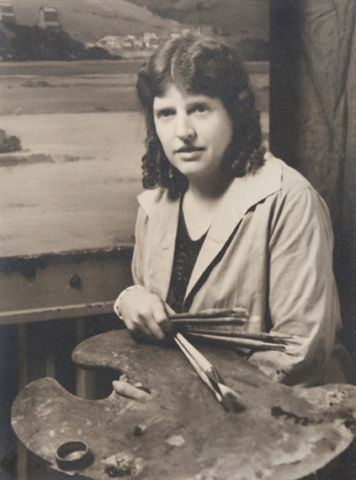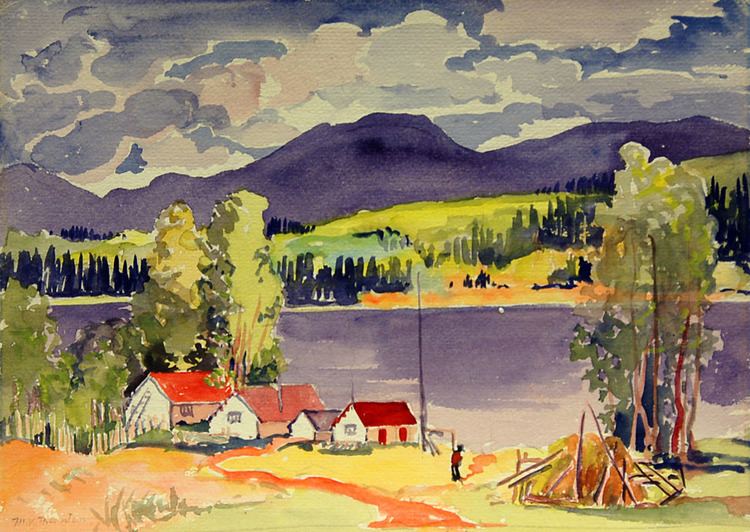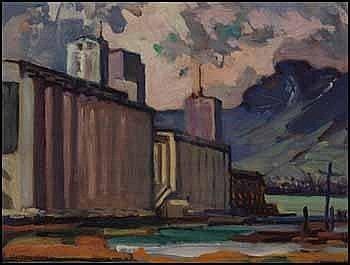Nationality Canadian Movement Post-Impressionism Education OCAD University | Name Mildred Thornton Known for Painter | |
 | ||
Full Name Mildred Valley Stinson Born 7 May 1890 Rutherford, Dawn, Lambton County, 0ntario, Canada Awards Fellow of Royal Society of Arts Died July 27, 1967, Vancouver, Canada Artwork The Touchwood Hills, Dance Masks of the Kwakiutl | ||
Mildred Valley Thornton's Canada - Storyhive Pitch
Mildred Valley Thornton (b. 7 May 1890; d. 27, July, 1967) was a Canadian artist. She is famous for her colourful paintings and writings about prairie and Northwest Coast First Nations people.
Contents
- Mildred Valley Thorntons Canada Storyhive Pitch
- Life and Training
- Early Phase 1910s 1920s
- Mid Phase late 1920 early 1930s
- Late Phase of Career 1930s 1960s
- Exhibitions Awards and Honours
- Representation
- References

Life and Training

Mildred Stinson was born in 1890 in Dresden, Ontario, Canada. She was from a farming family and developed a great affection for art from an early age.

In 1910, she studied at Oliver College in Michigan, USA. In the same year, she also studied with J.W. Beauty and George A. Reid at the Ontario College of Arts and the Art Institute of Chicago. In 1913, she moved to Regina, Saskatchewan with her family.
In 1915, Stinson married John Henry Thornton, a businessman from Sheffield, England and changed her name to Mildred Thorton. They had twin sons in 1926 named John Milton (Jack), and Walter Maitland.
In the early 1920s, Thornton began making extended sketching trips, living with the Plains Indians in their camps and tipis, painting their portraits and recording their legends. The Aboriginal peoples who included the Cree, Siksika, Kainai, Pikuni, Sarcee, and the Sioux, were initially suspicious of her motives, they gradually came to accept her, allowing her access to ceremonies and rituals which are not usually attended by white people. In her first book, Indian Lives and Legends, (published in 1966) she describes her primary passion and interest about paintings.
In 1929, her husband's business suffered because of the stock market crash, and they moved to Vancouver in 1934. She became a member of the Royal Society of Arts in 1954. She also got awards from Women's Art Association of Saskatchewan. She always used colors and oil for her paintings to make them different.
Thornton painted a number of landscapes and portraits which were not on the theme. These were the only works she would sell not because she received no offers to buy her paintings, but because she refused to part with the works individually, believing they must remain together in Canada and preferably in B.C. She called her more than three hundred works 'The Indian Collection,' and stored them in a Vancouver vault during her lifetime. Although she received offers to buy the Collection from West Germany, the British government and the United States, she would not allow it to leave the country because she believed it represented an integral part of our Canadian heritage.
Thornton died in July 27, 1967 in Vancouver, British Columbia, Canada. At the time of her death, 'The Indian Collection' was being exhibited and enjoyed in Vancouver as part of a Centennial tribute to Canada's Native people. Thornton had a codicil in her will that stated after her death her all of the paintings should be burned to ashes because of lack of some official support for her talent. But this was not acted upon on the grounds that it had not been legally witnessed. Therefore, the collection was saved but it has been mostly sold and dispersed.
Early Phase (1910s - 1920s)
Mildred Valley Thornton moved to Regina, Saskatchewan in 1913. There she was influenced by the living style of Aboriginal people. She was also impressed by the vast prairie landscape. In 1920, she began to paint professionally. She came to be known as a latter-day Emily Carr as she used to record native culture. It was the time when most of the women used to look after the family and did some household works. However, Thornton decide make her career in the field of painting and art. In her book named The Buffalo People, her son Jack explained that it was an important time when she began her art. It became great work of her life and gave her honour in the society after her death. Her work preserved on canvas. Mildred Stinson (name before marriage) married a businessperson from Sheffield, which was in England. His name was John Henry Thornton. He used to support her and took care of sons when she was out of city and busy in painting trips. She gave birth to twin sons in year of 1926 and their names were John Milton (Jack) and Walter Maitland. In 2010, her son Walter Maitland was no more so her second son John Milton allowed author Sheryl Salloum to see unpublished writings and paintings of her mother. Jack described his personal experience when he used to company her mother on painting trips to different areas. In beginning of 1920’s, she started planning trips and began living with the Plain Indians so that she could come to know more about her and understand their facial features in a better way . This helped her in making their portraits. She made portraits of great people who had name and fame in society. Earlier, Aboriginal people did not accept her work of art and did not trust her to great extent. With passage of time, they started recognising her work and appreciated her. They called her in their rituals and ceremonies so that she could understand them and their culture in a better way. In the first book of Thornton named Indian Lives and Legends, she discussed how she laid great stress on judging other body structure like head and shoulders so that she could enhance her portraits in a better way. In addition, she tried to notice the designs and colours of Indian dresses so that she could enhance the beauty of her masterpiece.
Mid Phase (late 1920 - early 1930s)
By 1928, Thornton was painting portraits of famous people of nation and she made this as a mission to preserve the pictures of great people so that others could come to know about them. Her work included renowned people of twenty-four First Nations. For instance, include British Columbia, Haida, Ktunaxa, Chilcotin, Sto:lo, Squamish, Tsimshian, Heiltsuk and many others. She was very quick in painting and mostly she had only single chance to paint her sitters. She used to pay them for giving their time to her. At that time, residential schools were eliminating First Nation’s languages, rituals, ceremonies, traditions and other important things. However, at the same time, Thornton was busy in publishing journals as well as articles, discussing and showing slides of her great work. Often, she used to play recordings of first songs of nations for various groups present in Canada and in England in 1959. Her motive was to eliminate any injustice that was going on with such generous people. Thornton was an advocate who was fighting and struggling for equal in opportunities and rights of many women. Not only this, but also she was a supporter of a community and an innovator in her ideas. In addition, first nation’s people used to get influenced by the struggle of Thornton that was being done for them. In 1929, her husband’s business suffered due to stock market crash and this forced her family to move to Vancouver.
Late Phase of Career (1930s - 1960s)
In 1934, she settled in Vancouver on Comox Street, near English Bay. She started painting portraits of people from different groups. Before this time, she used to paint portraits of native people. There she became famous as a critic, poet, lecturer as well as an ardent advocate who was aware about the rights of other human beings and knew how to fight for them. Her friend’s great-grand daughter named Deborah Jacobs made a collection of her portraits that based on ancestors of Squamish. She presented these in an exhibition that held in 1999. The result of painting such portraits was that it led to the formation of new educational program, which was extensive. Thornton attempted to depict the life and culture of aboriginal people in a pure and accurate manner. Her work was respected and appreciated by most of the people. Not only had she laid stress on painting portraits of native people but also she did a great job in painting landscapes in oil as well as watercolours. Her increasing number of portraits were like “The Collection” but she didn’t accept offer to sell her whole works all together. She made a decision to preserve them by offering them to the Government of Canada. When her husband died in 1958, she started living with one of her sons in England. Her work was selected for exhibitions in 1959 and 1961. In year of 1961, she came back to Vancouver. She was suffering from Leukemia, she continued to paint. In 1966, she published Indian Lives and Legends. In 2000, her second book named Buffalo People: Portraits of a Vanishing Nation was published. After her death, in 1967, her son reported that she died with a disappointment because the Government of Canada did not recognize her art. In her life, she got best awards that were the Kwakiutl and Owa-ka-esk-ean by people for whom she devoted her most of the life by doing painting. These were best honours that she got ever in her life.
Exhibitions, Awards and Honours
Mildred Valley Thornton dedicated much of her life to painting portraits, landscapes and 'rid her later work completely of human figures by travelling lonely in search of lives and culture of the Native People. Thornton's primary concern was portraiture. Thornton acquired wide acceptance by being known as a “lady who paints Indians”.
In 1920s, Thornton began to paint professionally as by painting portraits of more than 300 aboriginal people. Thornton’s records were not only visual as she had very friendly and strong bond with Native peoples which helped her out to know about their personal history. Thornton was one of those women artists who does not let their careers end after marriage. She pursues her career with even more devotion by some financial support and understanding of her husband. But due to 1929 stock market crash, her husband’s business got effected which led to depression and it forced the family to move to Vancouver Thornton. does not let her career ruined despite facing some economic obstacles. She moved her writing and painting zeal to Aboriginal people of British Columbia and to landscapes. She painted those people portraits, illustrated tribal ceremonies, their villages and other cultural activities by gaining trust of the Coastal Aboriginal peoples. Moreover, by gaining some experience from Olivet school of Art and the Art Institute of Chicago, 'she wrote poetry for the Vancouver Sun from 1944 to 1959 as an art critic'. Also Thornton stands for the rights and welfare of the Aboriginal peoples as an ardent advocate.
In 1954, Mildred Valley Thornton was warmly welcomed by the Royal Society of Arts. Canadian Women’s Press Club elected Thornton as a president of their club. But her greatest wish of accepting her donation of her work en masses by the Canadian government was not achieved. After her husband’s death in 1958, Thornton with one of her twin sons moved to England. In London, Royal Commonwealth Institute mounted some of her major work in 1959 and 1961 as they were attracted by the unique artistic production of Thornton but due to skin disease, she could not attend it. During her lifetime she received many honours, but the most precious to her were those bestowed by Aboriginal peoples: 'Kwakiutl of the Clan Eagle named Thornton “Ah-ou-Mookht,” meaning “the one who wears the blanket because she is of noble birth,” and Crees had named her “Owas-ka-esk-ean” meaning “putting your best ability for us”, which was really a proud movement for her.
Mildred Valley Thornton came back to Vancouver in 1961. In 1966, 'her first award-winning book “Indian Lives and Legends” was published by Mitchell Press, which visualises the profiles and legends of Native Peoples of British Columbia. In addition to this, her first book also includes twelve, hand-inserted colour plates. The second book of Mildred Valley Thornton was “Buffalo People: Portraits of a Vanishing Nation”, which was based on the stories, paintings and some images of her acquaintances with Plains Indians and was published in 2000. Thornton had really worked hard for her passion and faced many problems but despite facing difficulties she never gives up. Furthermore, Canadian Portrait Academy made Thornton an honorary member of the academy and in the same year one more proud movement was for her that she was honoured as one of the “Top 100 Portrait Artists in 20th Century Canada”.
Representation
Thornton's work is represented by the National Gallery of Canada. Her oil landscape painting “The Touchwood Hills" is on display.
